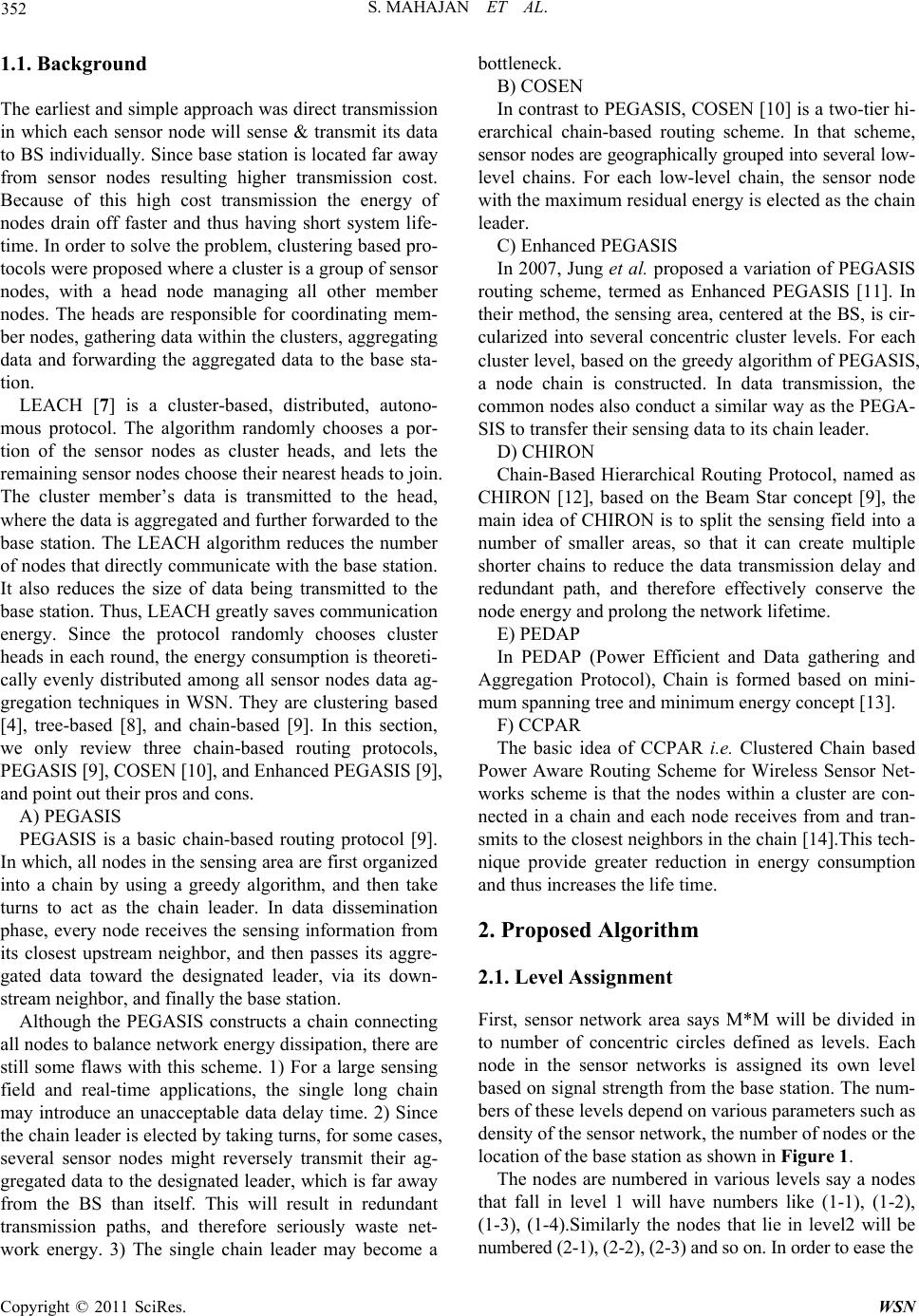
S. MAHAJAN ET AL.
352
1.1. Background
The earliest and simple approach was direct transmission
in which each sensor node will sense & transmit its data
to BS individually. Since base station is located far away
from sensor nodes resulting higher transmission cost.
Because of this high cost transmission the energy of
nodes drain off faster and thus having short system life-
time. In order to solve the problem, clustering based pro-
tocols were propo sed where a cluster is a gro up of sensor
nodes, with a head node managing all other member
nodes. The heads are responsible for coordinating mem-
ber nodes, gathering data within the clusters, aggregatin g
data and forwarding the aggregated data to the base sta-
tion.
LEACH [7] is a cluster-based, distributed, autono-
mous protocol. The algorithm randomly chooses a por-
tion of the sensor nodes as cluster heads, and lets the
remaining sensor nodes choose their nearest heads to join.
The cluster member’s data is transmitted to the head,
where the data is aggregated and further forwarded to the
base station. The LEACH algorithm reduces the number
of nodes that directly communicate with the base station.
It also reduces the size of data being transmitted to the
base station. Thus, LEACH greatly saves communication
energy. Since the protocol randomly chooses cluster
heads in each round , the energy consumption is theoreti-
cally evenly distributed among all sensor nodes data ag-
gregation techniques in WSN. They are clustering based
[4], tree-based [8], and chain-based [9]. In this section,
we only review three chain-based routing protocols,
PEGASIS [9], COSEN [10], and Enhanced PEGASIS [9],
and point out their pros and cons.
A) PEGASIS
PEGASIS is a basic chain-based routing protocol [9].
In which, all nodes in the sensing area are first organized
into a chain by using a greedy algorithm, and then take
turns to act as the chain leader. In data dissemination
phase, every node receives the sensing information from
its closest upstream neighbor, and then passes its aggre-
gated data toward the designated leader, via its down-
stream neighbor, and finally the base station.
Although the PEGASIS constructs a chain connecting
all nodes to balance network energy dissipation, there are
still some flaws with this scheme. 1) For a large sensing
field and real-time applications, the single long chain
may introduce an unacceptable data delay time. 2) Since
the chain leader is elected by taking turns, for some cases,
several sensor nodes might reversely transmit their ag-
gregated data to the designated leader, which is far away
from the BS than itself. This will result in redundant
transmission paths, and therefore seriously waste net-
work energy. 3) The single chain leader may become a
bottleneck.
B) COSEN
In contrast to PEGASIS, COSEN [10] is a two-tier hi-
erarchical chain-based routing scheme. In that scheme,
sensor nodes are geographically grouped into several low-
level chains. For each low-level chain, the sensor node
with the maximum residual energy is elected as the chain
leader.
C) Enhanced PEGASIS
In 2007, Jung et al. proposed a variation of PEGASIS
routing scheme, termed as Enhanced PEGASIS [11]. In
their method, the sensing area, centered at the BS, is cir-
cularized into several concentric cluster levels. For each
cluster level, based on the greedy algorithm of PEGASIS,
a node chain is constructed. In data transmission, the
common nodes also conduct a similar way as the PEGA-
SIS to transfer their sensing data to its chain leader.
D) CHIRON
Chain-Based Hierarchical Routing Protocol, named as
CHIRON [12], based on the Beam Star concept [9], the
main idea of CHIRON is to split the sensing field into a
number of smaller areas, so that it can create multiple
shorter chains to reduce the data transmission delay and
redundant path, and therefore effectively conserve the
node energy and prolong the network lifetime.
E) PEDAP
In PEDAP (Power Efficient and Data gathering and
Aggregation Protocol), Chain is formed based on mini-
mum spanning tree and minimum energy concept [13].
F) CCPAR
The basic idea of CCPAR i.e. Clustered Chain based
Power Aware Routing Scheme for Wireless Sensor Net-
works scheme is that the nodes within a cluster are con-
nected in a chain and each node receives from and tran-
smits to the closest neighbors in the chain [14].This tech-
nique provide greater reduction in energy consumption
and thus increases the life time.
2. Proposed Algorithm
2.1. Level Assignment
First, sensor network area says M*M will be divided in
to number of concentric circles defined as levels. Each
node in the sensor networks is assigned its own level
based on signal strength from the base station. The num-
bers of these levels depend on various parameters such as
density of the sensor network, the number of nodes or the
location of the base station as shown in Figure 1.
The nodes are numbered in various levels say a nodes
that fall in level 1 will have numbers like (1-1), (1-2),
(1-3), (1-4).Similarly the nodes that lie in level2 will be
numbered (2-1), (2-2), (2-3) and so on. I n order to ease the
Copyright © 2011 SciRes. WSN